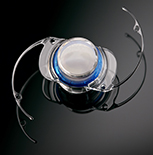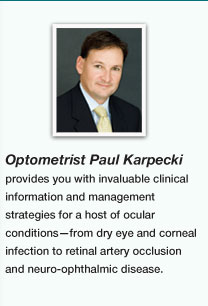 |
|
When I was in optometry school more than 20 years ago, we informed patients that they either had the slowly progressing form of AMD (dry/non-exudative) or the more visually devas-tating, rapidly progressing form (wet/exudative). At the time, little could be done to manage ei-ther disease type. Today, more than fifteen million patients suffer from some form of AMD.1 Fortunately, we now have a variety of sophisticated screening tools to help facilitate an earlier diagnosis, as well as several preventative strategies and novel treatment options and to help im-prove patients’ prognoses.
Early disease detection is essential when screening patients for signs of AMD. One advanced testing device, AdaptDx (Maculogix), uses dark adaptation to diagnose early macular degeneration. In AMD patients, macular cholesterol deposits hinder the normal transport of vitamin A across Bruch’s membrane, consequently reducing night vision and prolonging photobleaching recovery times. AdaptDx exposes the eye to a mild, bleaching flash; measures recovery status; and compares the result against a normative database. The test achieves greater than 90% specificity and sensitivity for a diagnosis of AMD early in the disease process.2
Additionally, genetic testing for AMD may be another valuable early disease detection tool. Such tests assess a patient’s overarching risk of AMD development, and can even help clinicians determine the likelihood and/or severity of disease progression.
Published in 2013, AREDS2 remains the largest, high-profile trial to evaluate the impact of nutritional supplements on the development and progression of AMD.3 The researchers clearly demonstrated that supplementation with the dietary carotenoids lutein and zeaxanthin can slow the progression of dry AMD.3
In addition to nutritional supplementation, blue-light filtering spectacles may help slow disease progression.4,5 Several companies manufacture such lenses, including VSP (UNITY BluTech), Nikon (SeeCoat Blue UV), Essilor (Crizal Prevencia), HOYA (Recharge), PFO Global (iBlu coat) and Spy Optic Inc. (Happy Lens).
Today, intravitreal anti-VEGF injections are a mainstream, first-line treatment approach for wet AMD. FDA-approved agents include Macugen (pegaptanib sodium, Bausch + Lomb), Lucentis (ranibizumab, Genentech/Roche) and Eylea (aflibercept, Regeneron). These agents have been shown to slow, halt and even reverse neovascularization, as well as improve and restore visual acuity.
Finally, even patients diagnosed with advanced AMD are not without hope. In July 2010, the Implantable Miniature Telescope (VisionCare Ophthalmic Technologies Inc.) received FDA approval. The device is inserted at the time of cataract surgery, and helps magnify imagery so that visual stimuli is perceived outside of the damaged macular region.
1. Age-related Macular Degeneration. American Academy of Ophthalmology. http://www.aao.org/bcscsnippetdetail.aspx?id=9711f063-ed7b-452b-8708-c4dad0d893e8 Accessed on 1/28/2016
2. Jackson GR. Invest Ophthalmol Vis Sci. 2014;55(3):1427-31.
3. Age-Related Eye Disease Study 2 Research Group. Lutein + zeaxanthin and omega-3 fatty acids for age-related macular degeneration: the Age-Related Eye Disease Study 2 (AREDS2) randomized clinical trial. 2013 May 15;309(19):2005-15.
4. Dillon J, Zheng L, Merriam JC, Gaillard ER. Transmission of light to the aging human retina: possible implications for age related macular degeneration. Exp Eye Res. 2004;79(6):753-9.
5. Algvere PV, Marshall J, Seregard S. Age-related maculopathy and the impact of blue light hazard. Acta Ophthalmol Scand. 2006;84(1):4-15.
|
 |







![]()